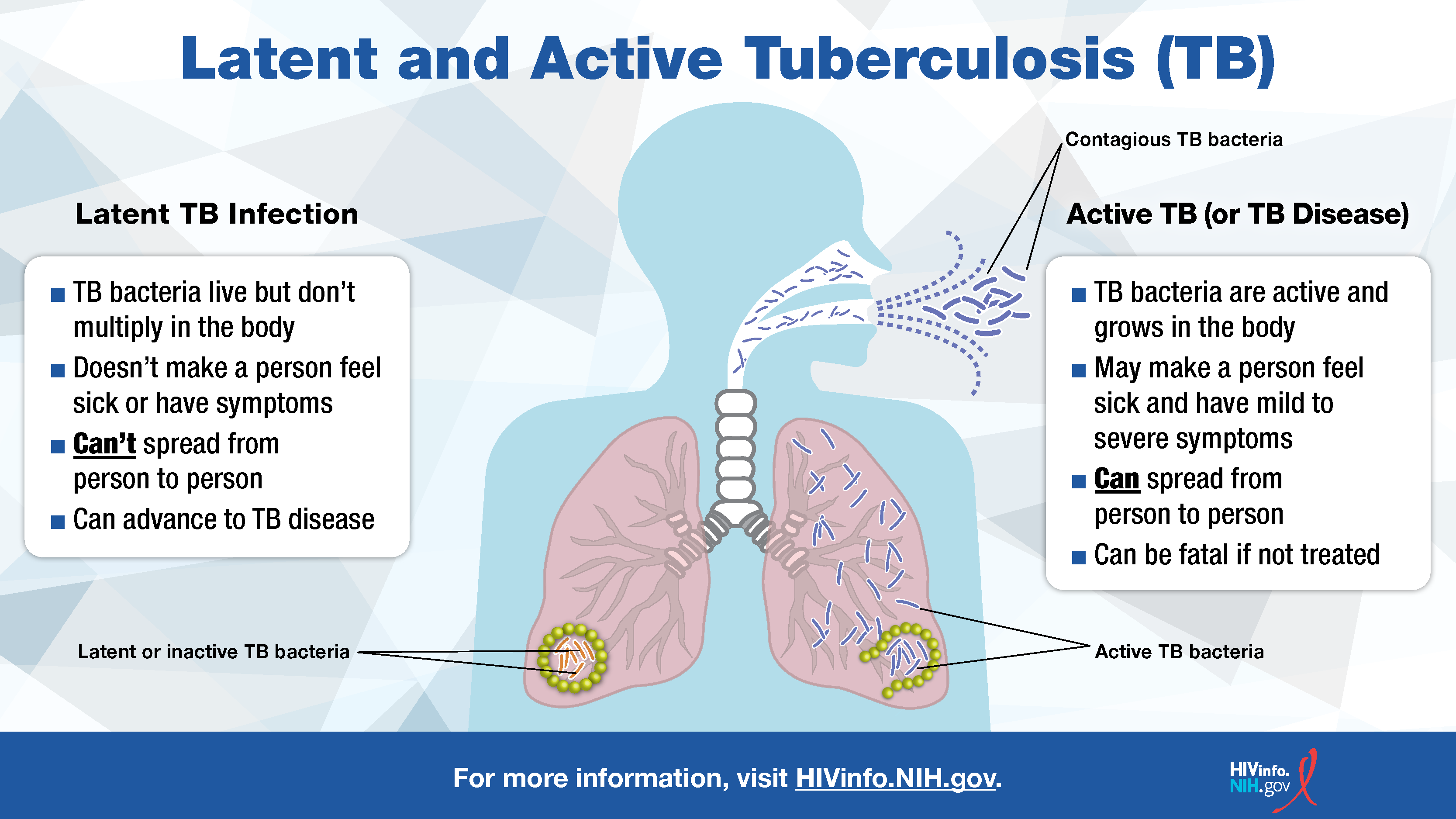HIV and Tuberculosis (TB)
Key Points
- Tuberculosis (TB) is a disease caused by a bacterium called Mycobacterium tuberculosis that spreads from person to person through the air.
- Because HIV weakens the immune system, people with HIV are more likely to get TB than people without HIV.
- TB usually affects the lungs, but it can affect any part of the body, including the kidneys, spine, or brain. If not treated, TB disease can cause death.
- People who have both HIV and TB should be treated for both diseases; however, when to start treatment and what medicines to take depends on a person’s individual circumstances.
What is tuberculosis?
Tuberculosis (TB) is an illness caused by the bacterium Mycobacterium tuberculosis. This bacterium can spread from person to person through tiny droplets in the air when a person with active TB coughs, sneezes, sings, or talks.
Once in the body, TB can be inactive or active. When the TB bacterium is inactive, this is called latent TB infection. People with latent TB infection are not contagious and may not have any symptoms, but the infection can become active.
When the TB bacterium is active, this is called TB disease. People with TB disease are contagious and are likely to experience symptoms. If untreated, TB disease can cause severe illness and may be fatal. The image below shows the difference between latent TB infection and TB disease.

What is the connection between HIV and TB?
TB is an opportunistic infection (OI). OIs are infections that occur more often or are more severe in people with weakened immune systems than in people with healthy immune systems. HIV weakens the immune system, increasing the risk of TB in people with HIV.
Infection with both HIV and TB is called HIV/TB coinfection. In people with HIV/TB coinfection, latent TB is more likely to advance to TB disease than in people without HIV. TB disease is among several life-threatening infections known as AIDS-defining conditions in people with HIV.
Treatment with HIV medicines, called antiretroviral therapy (ART), protects the immune system and prevents HIV from advancing to acquired immunodeficiency syndrome (AIDS). In people with HIV and latent TB infection, treatment with HIV and TB medicines reduces the chances that latent TB infection will advance to TB disease.
How common is HIV/TB coinfection?
In the United States, where HIV medicines are widely used, TB is relatively uncommon in people with HIV. According to the Centers for Disease Control and Prevention (CDC), roughly 300 to 400 people were diagnosed with HIV/TB coinfection each year from 2019 to 2023, accounting for just under five percent of all new TB cases.
TB disease still affects many people with HIV in the United States, especially those born outside the United States. Worldwide, TB disease is one of the leading causes of death among people with HIV.
Should people with HIV get tested for TB?
Yes, all people with HIV should get tested for TB infection. If test results show that a person has latent TB infection, additional testing is needed. More testing will determine whether the person has TB disease.
Some types of TB are resistant to certain types of TB medicine. If a person tests positive for TB, the laboratory will conduct additional testing to check if the TB is drug-resistant. In some cases, people with HIV will test negative for TB despite being infected with the bacterium, making it especially important to inform a health care provider about any TB-related symptoms.
What are the symptoms of TB?
People with latent TB infection have no symptoms. In contrast, people with TB disease that affects the lungs may have the following symptoms:
- A persistent cough that may bring up blood or sputum (or phlegm)
- Chest pain
- Weakness or fatigue
- Loss of appetite
- Weight loss
- Chills
- Fever
- Night sweats
Although TB usually affects the lungs, it can affect any part of the body, including the kidneys, spine, or brain. When TB disease affects other parts of the body, a person may have other symptoms.
What is the treatment for TB?
TB medicines are used to prevent latent TB infection from advancing to TB disease and to treat TB disease. The choice of TB medicines and the length of treatment depend on whether a person has latent TB infection or TB disease and whether they have drug-resistant TB.
People with HIV/TB coinfection should be treated for both HIV and TB; however, when to start treatment and what medicines to take depends on a person’s individual circumstances. Taking certain HIV and TB medicines at the same time can increase the risk of drug-drug interactions and side effects. People being treated for HIV/TB coinfection are carefully monitored by their health care providers.
It is important to take all TB medicines, like HIV medicines, exactly as prescribed. Missing doses or stopping treatment early can increase the likelihood of developing drug-resistant TB. If you have HIV/TB coinfection, talk to your health care provider about a treatment plan that works for you.
This fact sheet is based on information from the following sources:
From the CDC:
From the HIV Clinical Practice Guidelines at Clinicalinfo.HIV.gov:
- Guidelines for the Prevention and Treatment of Opportunistic Infections in Adults and Adolescents With HIV:
- Guidelines for the Use of Antiretroviral Agents in Adults and Adolescents With HIV:
Also see the HIV Source collection of HIV links and resources.
